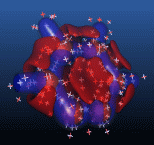|
|
Genetics Test 1
|
|||||||||||||||
|
Genetics *including answer
|
All questions are ranked out of five and then the section is prorated. (e.g., every question in Part B is worth equal value. Same applies to every question is A and C.) Part A: Easy Stuff. If you read the book and followed the study guide, this stuff should be a cinch. Worth 20% of the test. Use the box at the bottom of the next page.1) Look at Figure 14.4. Which characteristics could be used to do the sort of experiments Mendel did? a) None. b) All. c) Only the ones involving colour. d) Only the ones involving shape. e) Cannot be solved. 2) Look at Figure 14.5 (supplied for you). From this picture, it can be deduced that a) Yellow is dominant b) Green is dominant c) Neither is dominant d) Both are dominant e) Cannot be solved. 3) A geneticist is studying two different kinds of animals. Animal "a" is found to have a diploid number of 10. Animal "b" is found to have a diploid number of 44. Which conclusion is best? a) The animals are identical twins. b) Animal "b" is more intelligent than animal "a." c) Animal "b" is less intelligent than animal "a." d) Animal "b" is more evolved than animal "a." e) None of the above are good conclusions. 4) For human blood types (A, B, AB, and O), the situation is best described as: a) A and B are codominant, O is recessive to both A and B. b) A, B and O are all co-dominant. c) A and B are recessive to O. d) AB is dominant to AA and BB. e) None of the above. 5) Which of the following are examples of multiple allelism? a) Eye colour in Drosophila melanogaster (Fruit flies). b) Wing type in Drosophila melanogaster. c) Human ABO blood type. d) All of the above. e) None of the above. 6) If a cell's genome is 18% guanine, what percentage of it should be adenine? a) 18% b) 32% c) 36% d) 64% e) 82% 7) DNA replication is a) Conservative b) Semi-conservative c) Sometimes conservative, sometimes semi-conservative d) Liberal e) Green Part B: Do only 4 of these. Keep it short. 50 words should be more than enough, otherwise you'll run out of time. This section is worth 40%.1) There is a connection between Mendel's compensating mechanism, the diploid number, and chromosomes. What it the connection? 2) Suppose a trait for baldness is carried on the x-chromosome (sex-chromosome) in humans. Suppose also that the allele codes for either baldness or not. Does this explain why more men are bald that women? (Sinead O'Connor notwithstanding.) 3) Explain albinism is genetic and molecular terms. 4) What is the connection between crossing over, map units, and independent and dependent segregation? It may help you in answering this to know that Mendel's dihybrid crosses of (yellow smooth peas X wrinkled green) yielded yellow smooth and yellow wrinkled ratios that were not equal. 5) There are 2 classes of types of mutations. One class have four sub-types, one class has only one subtype. Name the 2 major classes and the 5 sub-classes. Pick one and explain in 25 words or less. Part C: Do all of these. This section is worth 40%.1) It has been said that about 40% of all human pregnancies "spontaneously abort shortly after implantation" (i.e., somewhere between the first day of implantation in the uterine wall and the second week of gestation, "something" happens). Ruling out interference from factors outside the womb, propose some molecular and genetic reasons why spontaneous abortions may occur. 2) Give the molecular genetics explanation for sickle-cell anemia. Talk about the molecular basis for the allele and the basis for the altered function. 3) Would Hershey & Chase been able to arrive the same conclusions had they used radioactively-labelled nitrogen instead of sulphur? Use diagrams of the amino acids and nucleotides in your answer. 4) Sketch & label Figure 16.4. What is the relevance to these ideas in prokaryotic (no nuclear membrane) versus eukaryotic cells?
|
